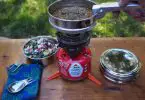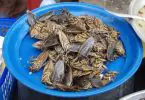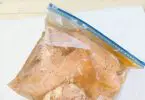Minimalism is everywhere these days – from tiny houses to sole less shoes, people are putting away the accessories in all their activities and opting for a simpler approach. Camping is no exception, and what better way to cut out the clutter than to cut out the kitchen?
Three days of nuts and dried fruit can leave a hiker longing for the freeze dried spaghetti but there’s a better way! In this article, we’ll go over a whole bunch of healthy, delicious no cook backpacking meals that will leave you satisfied.
We’ll go into some general tips for the no cook approach, as well as recipes for breakfast, lunch, dinner, and snacks to fully prepare you for your next camping venture!
Tips and Tricks
Before we get into making a meal plan, let’s go over some of the things you should consider when you’re (not) cooking. First, let’s look at the different types of foods you can use:
Food Types: Dry, Rehydrated and Fresh
Many people think that not bringing a stove means eating nothing but dry food. Not true! While dry, dehydrated, and freeze dried foods like nuts, granola, jerky, and dried fruit can be yummy and filling, you’re not limited to them just because you’re not cooking. In fact, eating dry foods actually dehydrates the body, and balancing them with fresh and rehydrated foods can be essential for maintaining good hydration – especially on longer trips.
When packing food to rehydrate keep in mind that freeze dried foods will rehydrate more easily in cold water than dehydrated food. Sugar and salt slow down the rehydration process, so wait to add them until after your meals are ready to go.
See also: Dehydrated Food Recipes: Just Add Water to These Delicious Dehydrated Meals
Fresh foods often add extra weight, but they’re full of nutrients that are often lost in the drying process. Apples, pears, and citrus fruits are heavy, but can last several days on the trail. Bananas, greens, and berries don’t last nearly as long, but if eaten quickly can be a terrific addition to any meal.
Bread products are easy to pack along and last a while. Things like pita, spinach wraps, tortillas, and naan don’t squish like sandwich bread and make for filling meals. Finally, tuna and chicken can be purchased in shelf stable sealed packages for a quick protein fix.
Savvy Camper Tricks
These next tips are some general suggestions to make sure that your meals are both delicious and safe to eat. First, size matters! Dried foods that you plan to rehydrate should be cut into small pieces and included with other foods their size for even rehydrating.
Some grains, like 5 minute rice and fine grind couscous can be rehydrated in cold water, while tougher and bigger grains won’t get past the crunchy phase. Dehydrated beans can be crushed into a powder and rehydrated for quick bean dip or hummus.
Finally, when rehydrating meals, always make sure you use clean water. If you’re using water sources on the trail, use a filter, sterilization tablets, or a UV light to make sure it’s safe to drink before mixing with your food. Remember, saving 1-2 pounds by not bringing a stove isn’t worth it if giardia is on the menu!
Breakfast for No Cook Champions
Here are three easy recipes for healthy, energy packed breakfasts to kick of your day!
Oatmeal and Fruit
This one may seem like a no brainer, but oatmeal is a backpacking staple for a reason! Oats are packed with fiber and essential minerals, and can help lower cholesterol. Whole oats release energy slowly, giving you an energy boost that lasts hours.
All you need is oats and powdered milk, just add water and you’ve got a healthy breakfast. For added taste and nutrition, include dried fruit like raisons, banana chips, freeze dried strawberries, or coconut flakes.
Chia Seeds And Breakfast Shake
This is another quick and easy breakfast meal that’s packed with nutrients and energy. Pre made breakfast shake powders usually contain a hefty dose of your essential vitamins and minerals, and many contain tons of protein for all day power. Chia seeds are nutritious too, and they also thicken drinks and add to the fullness factor. Simply mix chia seeds with your shake powder and hydrate with water.
Banana And Peanut Butter Spread
This breakfast is a little more labor intensive, but the payoff is sweet! Bananas ripen and bruise quickly, so if you have an aversion to brown spots you may want to skip them. If not, they make a delicious and nutritious part of the most important meal of the day.
Here’s what you need:
1 banana
½ cup of grape nuts or other hearty grain cereal
2 tbsp. of peanut butter
Tortillas or pita
Put the banana in a plastic bag and squish until it makes a paste. Add the peanut butter and grape nuts and mix well. Spread onto tortillas and enjoy!
Lunch Break Meals
Lunch is certainly this writer’s favorite meal of the day, and when you’re backpacking it usually offers and excuse for a much needed trail break. These three lunch meals are no cook options that you can prepare trailside or at camp.
Stuffed Bell Peppers
Bell peppers are not only a delicious vegetable (or are they a fruit?), but a convenient edible bowl as well! This recipe utilizes their easy shape to reduce the need for dishes on your lunch break.
Here’s what you need:
1 large bell pepper
1 cup of fine grind couscous
¼ cup of carrot flakes (or fresh carrots)
Hard cheese
Cured meat
Rehydrate the couscous and carrots with water in a plastic bag for 15 minutes. While the couscous sits, slice the bell pepper in half and scoop out the seeds. Dice a few chunks of meat and cheese to your taste.
When the couscous is soft, mix the meat and cheese in and scoop into the peppers and voila!
Curry Chicken Pasta Salad
Ramen noodles are another food option that will rehydrate in cold water, and you can combine them with all sorts of good ingredients to make a delicious no cook meal.
Here’s what you need:
1 packet of shelf stable chicken
1 packet of ramen noodles
2 packets of mayonnaise
¼ cup of dried peas or mixed vegetables
1 tbsp. onion flakes
1 tsp. curry powder
¼ tsp. ground ginger
Break up the ramen noodles and combine with the vegetables, onion flakes, and 1 ½ cups of water in a plastic bag. Let sit for 25-30 minutes.
While the noodles rehydrate, mix the curry, ginger, and mayonnaise into the chicken packet. Pour off any extra water from the noodles and mix in the chicken.
Pistachio Couscous
Here’s a quick, protein packed meal that you can prepare at home to bring with you, or make on the trail! Here’s what you need:
1 cup of fine grind couscous
½ cup of dried mixed vegetables
¼ cup of shelled pistachios
1 packet of balsamic vinaigrette
Mix the couscous and mixed vegetables in a plastic bag. Add 1 ½ cups of water and let hydrate for 15-20 minutes. Once the water is absorbed, mix in the vinaigrette and pistachios.
If you want to prepare this one at home, cook the couscous and vegetables and seal into plastic freezer bags or plastic wear before heading out, then mix the pistachios and dressing when you’re ready to eat!
Want more delicious backpacking lunch ideas? Check out our article on this yummy topic.
Dinner Recipes
Tomato Hummus Wraps
This meal takes advantage of the joy that is instant hummus. Chickpeas are full of protein and can be extremely filling – especially paired with spinach wraps or pita.
½ cup of instant hummus mix
2 tsp. tomato powder
1 tbsp. olive oil
4-5 tbsp. salsa
Pita, naan, or dipping bread
Mix the hummus mix and tomato powder with 2/3 cup of water and mix well. Top off with the olive oil and salsa for a layered dip, or mix and spread onto wraps or pita for an easy meal on the go.
Tuna And Lentils
Like chickpeas, lentils are a protein packed power food. However, they take a long time to cook when dry. For this recipe, fully cook the lentils before dehydrating them – or buy them already cooked and dehydrated. Here’s what you need:
½ cup dehydrated lentils
¼ cup dried spinach
1 tbsp. onion flakes
1 tbsp. chicken or veggie bouillon
2 tbsp. olive oil
1 packet shelf stable tuna filets
Salt and pepper
Combine the lentils, spinach, onion flakes, and bouillon in a plastic bag. Add 1 cup of water and rehydrate for 25-30 minutes.
Once rehydrated, stir in the olive oil and salt and pepper to taste. Serve with the tuna filets on a plate or in a bowl.
Pizza Wraps
It’s hard to argue that pizza is one of the best foods, well, ever. So, while you’re eating your beans and fruit, why not throw in a little comfort food? Cured meats like salami and pepperoni will last days on the trail with no refrigeration, as will hard cheeses – even sharp cheddar and jack cheese will last surprisingly long outside of the icebox.
Here’s what you need for pizza night:
¼ cup tomato powder
½ tsp. dried oregano
½ tsp. dried basil
Pepperoni or salami, sliced
Cheddar, gouda, asiago, or other hard cheese, sliced
Pita, naan, or wraps
Mix the tomato powder, oregano, and basil in a plastic bag or bowl. Add water one teaspoon at a time until the mix has a paste consistency. Spread on your pita and top with the cured meat and cheese!
Snacks, Desserts, and Treats
Oreo Pudding
Pudding is just one more wonderful food that can be made with no cooking required. Most dry pudding mixes work great on the trail, and dessert is an important mood booster after a rough hike.
Indulge in some Oreo pudding with only four ingredients:
1 packet of instant Oreo pudding mix (4 oz)
1 cup dry milk powder
2 cups water
Mini Oreo cookies, crushed
Simply mix the pudding mix, dry milk, and water together and mix for two minutes. Let it sit in a cold place (like a stream) for 20 minutes or until thickened. Top the pudding with crushed cookies and enjoy!
Homemade Granola
Granola and camping are like two peas in a pod, they can’t be separated! But there’s no reason to limit yourself to bland or expensive store bought granola varieties.
This simple recipe gives you the power to make your own granola, perfectly suited to your individual taste. Prepare at home and pack into baggies for easy, healthy, and delicious snacking. Here’s what you need:
3 cups rolled oats
½ cup chopped nuts
½ cup dried fruit
3 tbsp. brown sugar, packed
1/3 cup honey
¼ cup vegetable oil or melted coconut oil
1 tsp. vanilla extract
½ tsp. cinnamon
¼ tsp. salt
Preheat your oven to 300 degrees. Mix the brown sugar, salt, and cinnamon in a large bowl. Mix in the oats and set aside. Mix the honey, vegetable oil, and vanilla in a small bowl and stir until thoroughly combined. Pour the wet ingredients over the oats and mix until they are well coated.
Spread the oats evenly over a baking sheet and bake for 15 minutes, stir, and bake for another 10 minutes or until the oats are golden brown. Stir the granola occasionally while it cools, about 15 minutes. Once cool, mix in the fruit and nuts.
You can customize this recipe with any fruit and nuts you like – try almonds, walnuts, or cashews for nuts and coconut flakes or dried mango as fruit. For those with a sweet tooth you can toss in chocolate chips or candied dates, and for the health nut try sunflower or pumpkin seeds.
Kale Chips
As mentioned above, vegetables are often an overlooked part of the backpacker’s diet, especially greens. Kale chips are delicious and nutritious, and easy to make without spending a ton of money on fad priced, store bought products. All you need for this one is fresh kale, salt, and olive oil.
Preheat your oven to 300 degrees. Tear the kale leaves from the thick stems and put into a bowl. Toss with 1-2 tbsp. of olive oil until coated, and add salt to taste. Spread the leaves evenly on a baking sheet and bake for 15-20 minutes or until crisp, flipping once. The chips will crisp up even more once they cool, and you’re good to go!
Summing Things Up
And there you have it, eleven delicious recipes for your next backpacking trip. For these camping food ideas no cooking is required, but they’ll leave you satisfied just like any hot meal could!
For more backpacking food tips, do read our article for lots of ideas.
Featured Image Source: “Greek Blooger Camp Food” by Titanas is licensed under CC BY-SA 2.0







